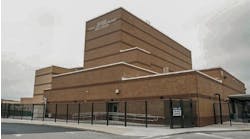Q: I am searching for a source to obtain ceiling materials for an old one-room school. The school had metal ceilings with a design. Where can we obtain materials to restore this building to its original beauty?— submitted via e-mail
A: As early as 1868, sheets of iron were being used as a finish ceiling treatment primarily as a means of fire protection. In their earliest use, these pressed-metal ceilings typically were corrugated but sometimes were stamped with ornamental designs. Commonly referred to by the misnomer “tin ceilings,” these sheet iron or sheet steel panels were not tin-plated; rather they typically were painted and occasionally galvanized to protect the ferrous metal from rusting. The panels were constructed in repetitive, regularly sized units with square field panels and accessories such as medallions and cornices. The panels were attached with nails, concealed as rosettes or other ornaments, to a wood furring or metal channel backup support. Popular well into the 1910s, pressed-metal ceilings offered advantages of being decorative, fire-resistant, inexpensive, easy to install and durable. Because of these characteristics, they were used in many buildings, including extensive use in schools.
Historic pressed-metal ceilings are highly durable when used in interior applications. Typically damage and deterioration occur because of exterior water infiltration, leaking piping and traumatic impact. Panels exhibiting deformation can be removed easily, the dents and dings pounded out, and the refurbished panels reinstalled. Holes can be soldered or filled with fiberglass-based patching products. Localized areas of rust can be removed and repaired. Larger areas of corrosion may require wholesale panel replacement. Repeated applications of paint can obscure the original detail, concealing the ceiling's original beauty. Paint can be removed with conventional paint strippers, but the process must be executed properly to reduce the hazards of removing lead-based paints. If the ceiling must be removed for installation of new concealed electrical conduit, sprinklers, piping or ductwork, the panels can be disassembled easily by removing the fasteners and cataloging the panels for later reinstallation.
Given the nearly limitless variety of historical designs, matching pressed-metal ceiling panels can be a challenge. Sometimes panels can be replaced by cannibalizing matching material from less visible locations in the building. If authentic restoration is desired, missing panels can be custom fabricated by making a mold directly from an existing panel (in good condition) from which a die is cast that can be used to stamp a new sheet-metal panel. In the event large sections of a ceiling are damaged beyond repair or are missing, the entire ceiling may require replacement. In this case, pressed-metal ceilings and accessories are readily available. An Internet search for “pressed-metal ceilings” will identify numerous sources for new ornamental metal ceiling products. Study any remnants of the original ceiling so that the new design will be compatible with the building's historic architectural character. Matching the original panel layout will simplify the ceiling installation and will result in an appearance where the design is resolved at the intersection of existing walls and cornices.
Cole, AIA, is with Swanke Hayden Connell Architects, New York City.

